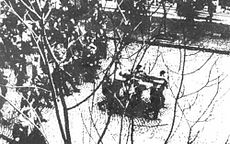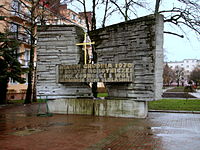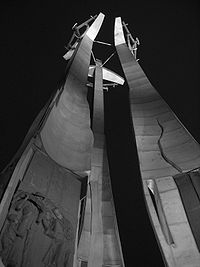- Polish 1970 protests
-
 Polish 1970 protests in Gdynia: body of Janek Wiśniewski (real name is Zbyszek Godlewski) is carried by the demonstrators.
Polish 1970 protests in Gdynia: body of Janek Wiśniewski (real name is Zbyszek Godlewski) is carried by the demonstrators.
The Polish 1970 protests (Polish: Grudzień 1970) were protests that occurred in northern Poland in December 1970. The protests were sparked by a sudden increase of prices of food and other everyday items. As a result of the riots, brutally put down by the Polish People's Army (under communist government control) and the Citizen's Militia, at least 42 people were killed and more than 1,000 wounded.
Contents
Background
Władysław Gomułka's temporary political success could not mask the economic crisis into which the People's Republic of Poland was drifting. Although the system of fixed, artificially low food prices kept urban discontent under control, it caused stagnation in agriculture and made more expensive food imports necessary. This was unsustainable, and in December 1970 the regime suddenly announced massive increases in the prices of basic foodstuffs. It is possible that the price rises were imposed on Gomułka by his enemies in the Party leadership who planned to manoeuvre him out of power[citation needed]. The rises were a fatal miscalculation, for they proved to be a major shock to the society and turned the urban workers against the regime.[1] Gomułka believed that the agreement with West Germany had made him more popular, but in fact most Poles appear to have felt that since the Germans were no longer a threat to Poland, they no longer needed to tolerate the Communist regime as a guarantee of Soviet support for the defence of the Oder-Neisse line.
The events
Demonstrations against the price rises broke out in the northern Baltic coastal cities of Gdańsk, Gdynia, Elbląg and Szczecin. Gomułka's right-hand man, Zenon Kliszko, made matters worse by ordering the army to fire on the workers as they tried to return to their factories. The regime was afraid of a wave of sabotage that was being started.[2][3] Another leader, Stanisław Kociołek, appealed to the workers to return to work. But in Gdynia the soldiers had orders to stop workers returning to work, and they fired into the crowd of workers emerging from their trains on December 17: hundreds of workers were killed or wounded. The protest movement then spread to other cities, leading to strikes and occupations. The government set in motion 5,000 members of special squads of police and 27,000 soldiers, equipped with heavy tanks and machine guns. Over 1,000 people were wounded, and at least 40 killed (other numbers often cited are 39[4] and 44[5] though the exact death toll remains unknown), 3,000 arrested, by modern accounts. However, only six people were reported dead by the government at the time. All those who perished were buried overnight, with only the closest relatives present, in order to avoid spreading the riots.
The resolution
The Party leadership met in Warsaw and decided that a full-scale working-class revolt was inevitable unless drastic steps were taken. With the consent of Leonid Brezhnev in Moscow, Gomułka, Kliszko and other leaders were forced to resign: if the price rises had been a plot against Gomułka, it succeeded. Since Moscow would not accept Mieczysław Moczar, Edward Gierek was drafted as the new leader. The price rises were reversed, wage rises announced, and sweeping economic and political changes were promised. Gierek went to Gdańsk and met the workers, apologised for the mistakes of the past, promised a political renewal and said that as a worker himself he would now govern for the people.[6]
Impact
Despite the fact that the aims of the protesters were mostly social and economical rather than political, the crushed riots had reinvigorated the dormant political activity of Polish society.[7]
See also
- Man of Iron, a movie by Andrzej Wajda where the massacre plays an important role.
- Janek Wiśniewski, a fictional name given to then-unknown young victim, immortalised in Janek Wiśniewski poem and songs.
- Strike, a Polish-German movie about Agnieszka Kowalska, a woman who played a major role in the Solidarity Movement.
- Brunon Drywa
Notes and references
-
- In-line:
- ^ (English) Daniel Singer (1981). The Road to Gdansk. Monthly Review Press,U.S.. pp. 157. ISBN 0-85345-567-8. http://books.google.com/?id=R1YKAAAAIAAJ&dq=Grudzie%C5%84+1970&q=December+1970.
- ^ Which however is often believed to be inspired by the secret police, who wanted to legitimize a harsh response to the protesters
- ^ (Polish) Jerzy Eisler, ed (2000). Grudzień 1970 w dokumentach MSW. Warsaw: Instytut Pamięci Narodowej. ISBN 83-11-09265-6. http://www.ipn.gov.pl/prace_grudzien70.html.
- ^ (Polish) "Polegli". Grudzień 1970. Magazyn Solidarność. Archived from the original on 2006-07-16. http://web.archive.org/web/20060716165041/http://www2.solidarnosc.gda.pl/grudzien70/Grudzien70_03.htm. Retrieved 2006-11-06.
- ^ (English) Piotr Golik (June 1998). "Answering for December 1970". Warsaw Voice (789). http://www.warsawvoice.pl/archiwum.phtml/789/. Retrieved 2006-11-06.
- ^ (Polish) Andrzej Burda, ed (1975). Sejm Polskiej Rzeczypospolitej Ludowej. Wrocław: Zakład Narodowy im. Ossolińskich. pp. 55. http://books.google.com/?id=aFcGAAAAMAAJ&q=Grudzie%C5%84+1970&dq=Grudzie%C5%84+1970.
- ^ (English) Bronisław Misztal (1985). Poland After Solidarity. Transaction Publishers. pp. 6. ISBN 0-88738-049-2. http://books.google.com/?id=5yeK_1TXSVwC&pg=PA6&lpg=PA6&vq=December+1970&dq=Grudzie%C5%84+1970.
External links
Polish uprisingsPartitions 
Second Republic World War II People's Republic Categories:- 1970 labor disputes and strikes
- 1970 in Poland
- Economic history of Poland
- History of Poland (1945–1989)
- Massacres in Poland
- Protests in Poland
- Anti-communism in Poland
- Cold War rebellions
Wikimedia Foundation. 2010.





